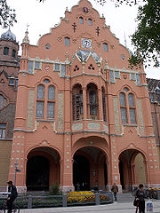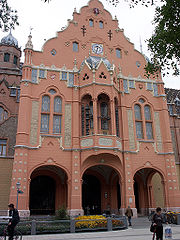
Gyula Pártos
Encyclopedia
Gyula Pártos was a Hungarian
architect
. Together with Ödön Lechner
he designed a number of buildings in the typical Secession
style of the turn of the century Hungary.
, gaining his degree in Berlin
in 1870. After this he established what was to be a fruitful partnership with Lechner which only ended in 1896, following the design of the Budapest Museum of Applied Arts. Working independently, he received some commissions in the capital as well as in Gyor
and Cegled
. Some of these followed in Lechner's footsteps but others leaned towards historicism.

Hungary
Hungary , officially the Republic of Hungary , is a landlocked country in Central Europe. It is situated in the Carpathian Basin and is bordered by Slovakia to the north, Ukraine and Romania to the east, Serbia and Croatia to the south, Slovenia to the southwest and Austria to the west. The...
architect
Architect
An architect is a person trained in the planning, design and oversight of the construction of buildings. To practice architecture means to offer or render services in connection with the design and construction of a building, or group of buildings and the space within the site surrounding the...
. Together with Ödön Lechner
Ödön Lechner
Ödön Lechner was a Hungarian architect, nicknamed the "Hungarian Gaudí".Lechner was one of the early representatives of the Hungarian Secession movement, called szecesszió in Hungarian, which was related to Art Nouveau and Jugendstil in the rest of Europe...
he designed a number of buildings in the typical Secession
Secession
Secession is the act of withdrawing from an organization, union, or especially a political entity. Threats of secession also can be a strategy for achieving more limited goals.-Secession theory:...
style of the turn of the century Hungary.
Career
At the beginning of his career he studied under Antal SzkalnitzkyAntal Szkalnitzky
Antal Szkalnitzky was a Hungarian architect.-Life:Born in Lak , a small town near Pécs, Szkalnitzky went on to study architecture in Prague, Vienna and Berlin, completing his degree in 1859. His numerous later travels took in places such as Transylvania, Dalmatia, Croatia and Italy...
, gaining his degree in Berlin
Berlin
Berlin is the capital city of Germany and is one of the 16 states of Germany. With a population of 3.45 million people, Berlin is Germany's largest city. It is the second most populous city proper and the seventh most populous urban area in the European Union...
in 1870. After this he established what was to be a fruitful partnership with Lechner which only ended in 1896, following the design of the Budapest Museum of Applied Arts. Working independently, he received some commissions in the capital as well as in Gyor
Gyor
-Climate:-Main sights:The ancient core of the city is Káptalan Hill at the confluence of three rivers: the Danube, Rába and Rábca. Püspökvár, the residence of Győr’s bishops can be easily recognised by its incomplete tower. Győr’s oldest buildings are the 13th-century dwelling tower and the...
and Cegled
Cegléd
Cegléd is a city in Pest county, Hungary, approximately southeast of the Hungarian capital, Budapest.-Name:There are discussions going on about the origin of the name of the town...
. Some of these followed in Lechner's footsteps but others leaned towards historicism.
Works

- 1882 SzegedSzeged' is the third largest city of Hungary, the largest city and regional centre of the Southern Great Plain and the county town of Csongrád county. The University of Szeged is one of the most distinguished universities in Hungary....
City Hall, together with Ödön LechnerÖdön LechnerÖdön Lechner was a Hungarian architect, nicknamed the "Hungarian Gaudí".Lechner was one of the early representatives of the Hungarian Secession movement, called szecesszió in Hungarian, which was related to Art Nouveau and Jugendstil in the rest of Europe... - 1882 - 1884 Hungarian Railway Pensioners Building (MÁV Nyugdíjintézet bérháza), Budapest, together with Ödön LechnerÖdön LechnerÖdön Lechner was a Hungarian architect, nicknamed the "Hungarian Gaudí".Lechner was one of the early representatives of the Hungarian Secession movement, called szecesszió in Hungarian, which was related to Art Nouveau and Jugendstil in the rest of Europe...
- 1885-1886 Zrenjanin City HallZrenjanin City HallZrenjanin City Hall is located at the Trg Slobode in Zrenjanin, Serbia. It is a seat of the Zrenjanin municipality.- History :...
, present-day SerbiaSerbiaSerbia , officially the Republic of Serbia , is a landlocked country located at the crossroads of Central and Southeast Europe, covering the southern part of the Carpathian basin and the central part of the Balkans...
,together with Ödön LechnerÖdön LechnerÖdön Lechner was a Hungarian architect, nicknamed the "Hungarian Gaudí".Lechner was one of the early representatives of the Hungarian Secession movement, called szecesszió in Hungarian, which was related to Art Nouveau and Jugendstil in the rest of Europe...
. - 1890 GymnasiumGymnasium (school)A gymnasium is a type of school providing secondary education in some parts of Europe, comparable to English grammar schools or sixth form colleges and U.S. college preparatory high schools. The word γυμνάσιον was used in Ancient Greece, meaning a locality for both physical and intellectual...
of Sremski KarlovciSremski KarlovciSremski Karlovci is a town and municipality in Serbia, in the autonomous province of Vojvodina, situated on the bank of the river Danube, 8 km from Novi Sad...
,together with Ödön LechnerÖdön LechnerÖdön Lechner was a Hungarian architect, nicknamed the "Hungarian Gaudí".Lechner was one of the early representatives of the Hungarian Secession movement, called szecesszió in Hungarian, which was related to Art Nouveau and Jugendstil in the rest of Europe...
. present-day SerbiaSerbiaSerbia , officially the Republic of Serbia , is a landlocked country located at the crossroads of Central and Southeast Europe, covering the southern part of the Carpathian basin and the central part of the Balkans...
. - 1893 KecskemétKecskemétKecskemét is a city in the central part of Hungary. It is the 8th largest city of the country, and the county seat of Bács-Kiskun.Kecskemét lies halfway between the capital Budapest and the country's third-largest city, Szeged, 86 kilometres from both of them and almost equal distance from the two...
City HallCity Hall (Kecskemét)The Kecskemét City Hall is the house of the main administration of the city of Kecskemét, Bács-Kiskun County, Hungary. It was built in 1893.The building was designed by Ödön Lechner and Gyula Pártos...
, together with Ödön LechnerÖdön LechnerÖdön Lechner was a Hungarian architect, nicknamed the "Hungarian Gaudí".Lechner was one of the early representatives of the Hungarian Secession movement, called szecesszió in Hungarian, which was related to Art Nouveau and Jugendstil in the rest of Europe...
. - 1900 Royal Hungarian Vocational School of Mechanics and Watchmaking, Budapest
- 1905 Black Eagle building in HódmezővásárhelyHódmezovásárhelyHódmezővásárhely , Romanian: Ioneşti) is a city in south-east Hungary, on the Great Hungarian Plain, at the meeting point of the Békés-Csanádi Ridge and the clay grassland surrounding the river Tisza...

